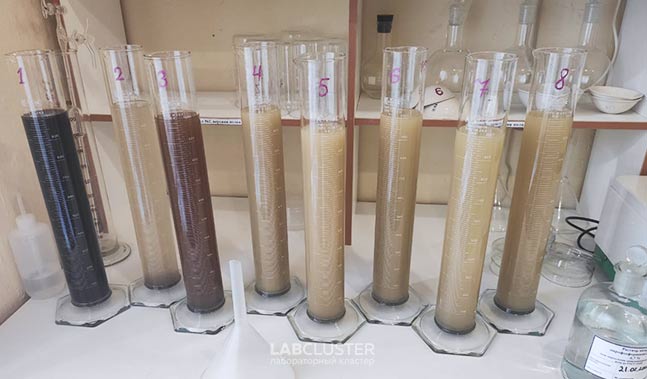Granulometric composition is an important physical characteristic of soils that determines their water-physical (plasticity, fluidity, porosity, moisture capacity, etc.), physical and chemical (absorption capacity) and thermal properties (thermal conductivity, etc.). Granulometric composition of the soil is determined by the ratio of granulometric fractions united in conditional size groups: stony part (>1 mm), sand (0.05-1 mm), dust (0.001-0.05 mm), silt (<0.001 mm).
Granulometric fractions (according to N. A. Kachinsky)

In science and practice, classifications are used in which the division of soils and grounds by main lithological types is based on a relative content of the sum of fractions less than 0.01 mm (so-called physical clay) and more than 0.01 mm (so-called physical sand). The most widely used two classifications of granulometric composition: for grounds the classification of Okhotin is used, for soils - the classification of Kachinsky.
An example of a classification of soils by Kachinsky
|
Soil type |
Contents of phys.clay, % |
|
Sandy |
0,1-10 |
|
Sandy-loam |
10-20 |
|
Light loam |
20-30 |
|
Medium loam |
30-40 |
|
Heavy loam |
40-50 |
|
Clayey |
More than 50 |
Why conducting laboratory research of the granulometric composition of the soil is needed?
According to the results of research on the composition of grounds certain decisions are made in various fields of activity:
· Data of the ground granularity in combination with other physical parameters determine the bearing capacity of the ground – the main characteristic that you need to know when constructing buildings, showing the load that a unit of ground area can withstand;
· In case of detection of an increased content of dangerous chemicals, environmental engineers and sanitary physicians assess the degree of chemical contamination of the soil by comparing the data obtained with the estimated permissible concentrations of chemicals in the soil (APC), the value of which, in turn, varies depending on the composition of the soil.
· When carrying out agricultural activities, land users need to have information about the composition and content of agronomically valuable aggregates in the soils of cultivated areas in order to take measures aimed to increase land fertility. The most suitable for the cultivation of major agricultural crops are light loamy soils with a predominance of aggregates ranging in size from 0.25 to 10 mm.
In addition, data on the composition of soils, in particular bottom deposits, are of scientific value in the research of sedimentation conditions in various water bodies, which also finds its application in the field of engineering surveys. In addition, data on the composition of soils, in particular bottom deposits, are of scientific value in the research of sedimentation conditions in various water bodies, which also finds its application in the field of engineering surveys.
Methods for determining the granulometric composition of soil in the area of laboratory accreditation.
Our laboratory is accredited for laboratory methods for determining the granularity of soils according to GOST 12536.
We perform ground analysis within the scope of the standard measurement methodology using all available methods:
· Wet sieving – used for analysis of dispersed organic-mineral grounds in a state of natural humidity using sieves with a cell diameter 10; 5; 2; 1; 0,5; 0,25 and 0.1 mm.

· Dry sieving is used for analysis of dispersed mineral grounds in an air-dry state using sieves with a cell diameter 10; 5; 2; 1; 0,5; 0,25 and 0.1 mm. Our laboratory is equipped with a vibrating screen PE-6800, which allows more efficient fractionation of samples.
· Areometric method is used for analysis of dispersed loam and clay grounds using a ground areometer. This method determines the content of small fractions of ground size <0.05 mm; >0.01 mm and >0.002 mm. The method is based on determining the density of water-ground suspension by taking a reference on the areometer at different intervals after stirring the suspension.
· Pipette method is used for the analysis of dispersed loam and clay grounds in combination with the areometric method using the Kachinsky pipette when determining the content of soil fraction size <0.001 mm, as well as for special purposes, when determining the content of fractions size <0.05 mm; <0.01 mm; <0.005 mm; and <0.001 mm. The analysis includes sampling of 25 cm3 samples from the prepared soil suspension in a measuring cylinder with a capacity of 1 dm3 using a Kachinsky pipette from a certain depth at different intervals after stirring the suspension, followed by drying and gravimetric determination of the mass of the selected fractions. Pipette analysis is based on the principle of sedimentology – Stokes' law, according to which ground particles of a certain size at a known value of the density of ground particles (a separate research is conducted) are deposited in distilled water to a certain depth for a set time (table value).
The final calculation of the ground granulometric composition is based on the results of a complex of sieve, areometric and (or) pipette methods with an indication of the percentage of 12 (cut method) or 13 (extended method) granulometric fractions.
If necessary, our specialists will determine the type of ground for you according to the granulometric composition in accordance with the accepted classifications.






